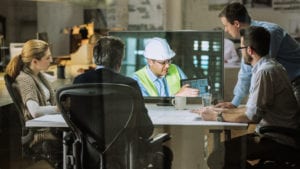Quick, how can you boost your hotel’s bottom line?
One answer is blowing in the wind – or rather, blowing in the air conditioning. The typical high-end guestroom uses 50 to 70 kW of energy a day … and a luxury room often tops more than 80kW a day. Of that, roughly half goes to heating and air conditioning. Yes, half.
Did you know that this new (and here to stay) fad, we call “smart energy management,” has a direct link to a better bottom line and a greater return on investment? Of course, you want more than my blog as proof. Well, consider this from the big guns: according to Energy Star, a 10% reduction in energy consumption has the same effect as increasing the average daily room rate (ADR) by as much as $1.35. That’s significant. Very.
What your guests want
At first glance, cutting energy usage by a tenth seems easy. After all, rented rooms are unoccupied almost two-thirds of the day. What’s more, most hotels operate at a 70-80% occupancy rate. That in-and-of-itself seems to leave plenty of room to significantly reduce energy consumption. All that’s needed is a way to turn down the climate control set point in the winter and turn it up in the summer for those times when a room is empty.
There’s just one pesky problem with this seemingly simple picture. These days, with advanced technology at our fingertips – and a heightened focus on a greener world – hotel guests expect their room to be comfortable upon arrival and to remain comfortable throughout their stay. Not an unreasonable request for the money these guests pay for their guestrooms, in which they spend an average of less than 8 hours per day (mostly to sleep). This proactive step of improving comfort (and control) is how you enhance the guest experience. With that, heating and cooling systems had better be pretty smart about determining when a room is empty and somehow anticipate when guests are about to check-in or return.
Don’t forget your balloon
In dealing with some not-so-smart systems, guests have been known to literally turn to balloons to fool motion detectors, as noted in my recently published blog post (it’s true – take a peek!) and resort to permanently inserting a second card into a card holder slot. They do so to fool or bypass automated occupancy checks. In essence, guests will find ways to implement their own control for their own comfort. Not a great guest experience. And, not exactly the advanced technology our 4-5 star hotels can easily offer their guests today.
A better solution than this aged approach is an intelligent standalone room control system that is equipped with presence detection sensors and door/window contact sensors. Sounds sensible enough – yet surprisingly these kinds of sensors are not installed in as many guestrooms as you might think. Energy management experts, such as Schneider Electric, realize this and pride themselves on offering guestroom solutions that optimize a hotel’s energy & building performance. With these more intelligent and industry-leading solutions, when the guestroom is unoccupied for a pre-defined period of time, these room controller devices (advanced thermostats) enable the climate control system to go into deep setback, during which the room temperature may depart many degrees from the ideal occupied temperature. Also, aside from designated outlets, electrical circuits are turned off when the room is empty.
Also, as noted in a recent article from HPAC Engineering, “Over the last several years, guest-room energy-management systems (EMS) have become more sophisticated, utilizing sensors and controls to adjust HVAC, lighting, and other systems based on room-occupancy status.” It’s becoming more and more apparent that the new wave of guest delight will begin in optimizing the guestroom.
The proof is in the guestroom
A commercial case study of this approach in a five-star hotel showed the system would pay for itself in just 3.5 years. The internal rate of return was almost 19%. Or consider a year-long Department of Energy case study of occupancy-based control of HVAC (heating, ventilating and air conditioning) of actual hotel rooms in three cities. This resulted in energy savings of 11 to 27%.
All of those numbers sound good, but it’s possible to do even better. As I said earlier, guests expect a comfortable stay – and want control of their own comfort. Sweating – or shivering – while waiting for their room to become comfortable is not ideal … but rest assured it is an experience they won’t soon forget. A standalone system only communicates inside a room. So, it has no automated way of knowing that an expected guest has just checked in and is on the way.
The value of connecting
To automate and anticipate a guest’s arrival/departure from the guestroom, you need networking and a BMS (Building Management System), and a PMS (Property Management System). Then, the front desk, HVAC, and other systems can be integrated, so rooms that are going to be unoccupied for a long time can go into deep setback. HVAC cost reductions would then potentially have a better chance to hit 20% or more. Remember, in the case study the high end number was in the upper 20s.
Networking brings other ROI pluses, with an important one being increased guest comfort. As we all know, increased guest comfort equals increased guest satisfaction – and this is a hoteliers #1 priority. A study showed that a hotel that raises its review score by 1 point on a 5-point scale can charge 11 percent more. Now that is something to think about. Networking and an intelligent, capable BMS enables room pre-heating or pre-cooling, language customization of greetings, and improved room maintenance. All of these efforts increase guest comfort, with the last also potentially reducing maintenance costs by allowing preventive, and not just reactive, repairs.
It’s worth your investment
So, what am I trying to tell you with all of this? It’s simple. An investment in energy management is a win-win. Your guests will enjoy a noticeably improved stay (and they remember it, which is key to ensuring return visits) – and your bottom line enjoys a noticeably improved boost.
Some hoteliers, understandably so, still have concerns about the cost and affect on guests…but those concerns are quickly being put to rest. As the HPAC Engineering article also notes, “Though hotel guest rooms may hold great potential for cost savings, concerns about the impact of energy-efficiency initiatives on customer satisfaction have kept many hoteliers from investing in energy-management solutions. With recent advances in building-management systems (BMS) and sensors, however, the balance between energy savings and guest comfort easily can be struck.”
To maximize your ROI, use a solution that’s both advanced and networked. That is where you will see the biggest bang for your buck – bringing long-term benefits to you and long-term loyalty from your guests. So…it’s more simple than you might think! Get connected. Your guests will like it!
I’d love to hear your thoughts on this and invite you to share them below.


